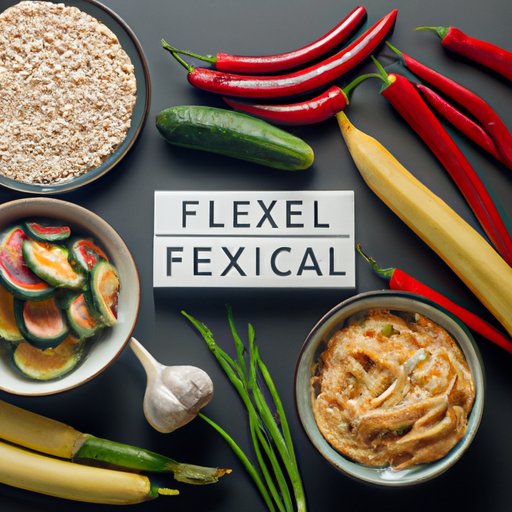
The Flexitarian Diet: A Guide to Eating Less Meat and More Plants
If you’re someone who is interested in consuming less meat but not ready to go completely vegetarian, then the flexitarian diet might be the perfect solution for you. As the name suggests, flexitarianism is a flexible approach to eating that emphasizes plant-based foods while still allowing for occasional meat consumption. In this article, we will explore the basics of a flexitarian diet, its benefits for both health and sustainability, and practical tips for transitioning into the diet.
“The Flexitarian Diet: Balancing Health and Sustainability”
One of the primary benefits of the flexitarian diet is its positive impact on one’s health. Consuming more plant-based foods, such as fruits, vegetables, nuts, and legumes, has been linked to lower rates of chronic diseases, including heart disease, diabetes, and some forms of cancer. In addition, a flexitarian diet can help individuals maintain a healthy weight and improve their overall well-being.
Another important aspect of flexitarianism is its sustainability. Eating less meat can significantly reduce one’s carbon footprint, as meat production is a major contributor to greenhouse gas emissions. The flexitarian diet allows individuals to do their part in minimizing the environmental impact of their diet without having to give up meat completely.
Furthermore, flexitarianism allows for flexibility and enjoyment in one’s diet. It doesn’t require strict rules, making it a more attainable and enjoyable lifestyle for many people. This flexibility and adaptability mean that individuals can still enjoy their favorite foods while consuming more plant-based foods overall.
“The Ultimate Guide to Flexitarianism – What It Is and How to Do It Right”
At its core, the flexitarian diet involves reducing meat intake while increasing consumption of plant-based foods. There’s no set rule as to how much meat one should consume, but a general guideline is to aim for a plant-centric diet, with meat serving as more of a side dish than a centerpiece.
If you’re interested in transitioning to a flexitarian diet, there are several practical tips that can help make the process easier. Start by incorporating more plant-based foods into your diet, such as substituting beans for meat in some recipes or trying a meatless meal once or twice a week. Gradually reducing your meat intake can help you adjust to the diet and make the transition more sustainable in the long run.
Additionally, being mindful of your nutrition is crucial when it comes to flexitarianism. Make sure to include a variety of nutrient-dense plant-based foods to ensure that you’re getting all the vitamins, minerals, and protein your body needs. Consider consulting a nutritionist or dietician if you have any concerns about whether you’re meeting your dietary needs.
“Flexitarianism for Beginners: How to Reduce Your Meat Intake Without Sacrificing Flavor”
If you’re new to flexitarianism, it’s natural to feel hesitant about giving up some of your favorite meat-based dishes. However, there are countless delicious and satisfying plant-based recipes that can help ease your transition to a meat-reduced diet.
Some easy and flavorful recipes include roasted vegetable and chickpea salads, lentil and vegetable stews, and quinoa-based bowls with a variety of toppings. You could also try making vegetable-based versions of some of your favorite meat dishes, such as lentil shepherd’s pie or vegetable lasagna.
There are plenty of plant-based meat alternatives on the market as well, such as tofu, tempeh, and seitan, which can be used in place of meat in many recipes.
“How Flexitarianism Can Help Save the Planet”
Meat production is a major contributor to deforestation, water pollution, and climate change. Consuming fewer animal products and more plant-based foods is one of the most effective ways individuals can reduce their carbon footprint. By transitioning to a flexitarian diet, individuals can significantly reduce their environmental impact.
According to recent statistics, if everyone in the US were to switch to a flexitarian diet, it would save the equivalent of 390 million metric tons of greenhouse gas emissions annually. This is equivalent to removing 84 million cars from the road each year.
“Personal Stories: Why I Decided to Become a Flexitarian”
It can be empowering and inspiring to hear stories from others who have made the switch to a flexitarian diet. This section will showcase personal stories from different regions, cultures, and backgrounds, featuring individuals who made the switch for different reasons.
For some, they made the switch for ethical reasons, such as concerns about animal welfare or the environmental impact of meat production. Others did it for health reasons, such as to reduce their risk of chronic diseases or improve their overall well-being. Whatever their reasons may be, these personal stories demonstrate that the flexitarian diet can work for anyone, regardless of their lifestyle or dietary preferences.
Conclusion
The flexitarian diet is a flexible and sustainable approach to eating that emphasizes plant-based foods while still allowing for occasional meat consumption. The diet’s benefits include improved health outcomes, lower carbon footprint, and flexibility in food choices. If you’re interested in reducing your meat intake and incorporating more plant-based foods into your diet, the flexitarian diet may be worth considering.




